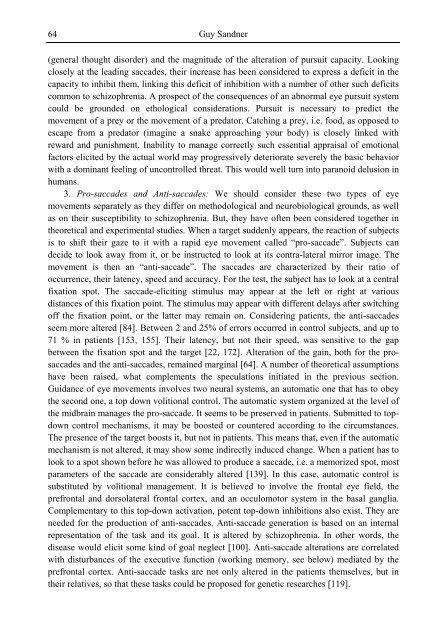Schizophrenia Research Trends
Schizophrenia Research Trends
Schizophrenia Research Trends
- No tags were found...
You also want an ePaper? Increase the reach of your titles
YUMPU automatically turns print PDFs into web optimized ePapers that Google loves.
64Guy Sandner(general thought disorder) and the magnitude of the alteration of pursuit capacity. Lookingclosely at the leading saccades, their increase has been considered to express a deficit in thecapacity to inhibit them, linking this deficit of inhibition with a number of other such deficitscommon to schizophrenia. A prospect of the consequences of an abnormal eye pursuit systemcould be grounded on ethological considerations. Pursuit is necessary to predict themovement of a prey or the movement of a predator. Catching a prey, i.e. food, as opposed toescape from a predator (imagine a snake approaching your body) is closely linked withreward and punishment. Inability to manage correctly such essential appraisal of emotionalfactors elicited by the actual world may progressively deteriorate severely the basic behaviorwith a dominant feeling of uncontrolled threat. This would well turn into paranoid delusion inhumans.3. Pro-saccades and Anti-saccades: We should consider these two types of eyemovements separately as they differ on methodological and neurobiological grounds, as wellas on their susceptibility to schizophrenia. But, they have often been considered together intheoretical and experimental studies. When a target suddenly appears, the reaction of subjectsis to shift their gaze to it with a rapid eye movement called “pro-saccade”. Subjects candecide to look away from it, or be instructed to look at its contra-lateral mirror image. Themovement is then an “anti-saccade”. The saccades are characterized by their ratio ofoccurrence, their latency, speed and accuracy. For the test, the subject has to look at a centralfixation spot. The saccade-eliciting stimulus may appear at the left or right at variousdistances of this fixation point. The stimulus may appear with different delays after switchingoff the fixation point, or the latter may remain on. Considering patients, the anti-saccadesseem more altered [84]. Between 2 and 25% of errors occurred in control subjects, and up to71 % in patients [153, 155]. Their latency, but not their speed, was sensitive to the gapbetween the fixation spot and the target [22, 172]. Alteration of the gain, both for the prosaccadesand the anti-saccades, remained marginal [64]. A number of theoretical assumptionshave been raised, what complements the speculations initiated in the previous section.Guidance of eye movements involves two neural systems, an automatic one that has to obeythe second one, a top down volitional control. The automatic system organized at the level ofthe midbrain manages the pro-saccade. It seems to be preserved in patients. Submitted to topdowncontrol mechanisms, it may be boosted or countered according to the circumstances.The presence of the target boosts it, but not in patients. This means that, even if the automaticmechanism is not altered, it may show some indirectly induced change. When a patient has tolook to a spot shown before he was allowed to produce a saccade, i.e. a memorized spot, mostparameters of the saccade are considerably altered [139]. In this case, automatic control issubstituted by volitional management. It is believed to involve the frontal eye field, theprefrontal and dorsolateral frontal cortex, and an occulomotor system in the basal ganglia.Complementary to this top-down activation, potent top-down inhibitions also exist. They areneeded for the production of anti-saccades. Anti-saccade generation is based on an internalrepresentation of the task and its goal. It is altered by schizophrenia. In other words, thedisease would elicit some kind of goal neglect [100]. Anti-saccade alterations are correlatedwith disturbances of the executive function (working memory, see below) mediated by theprefrontal cortex. Anti-saccade tasks are not only altered in the patients themselves, but intheir relatives, so that these tasks could be proposed for genetic researches [119].
















